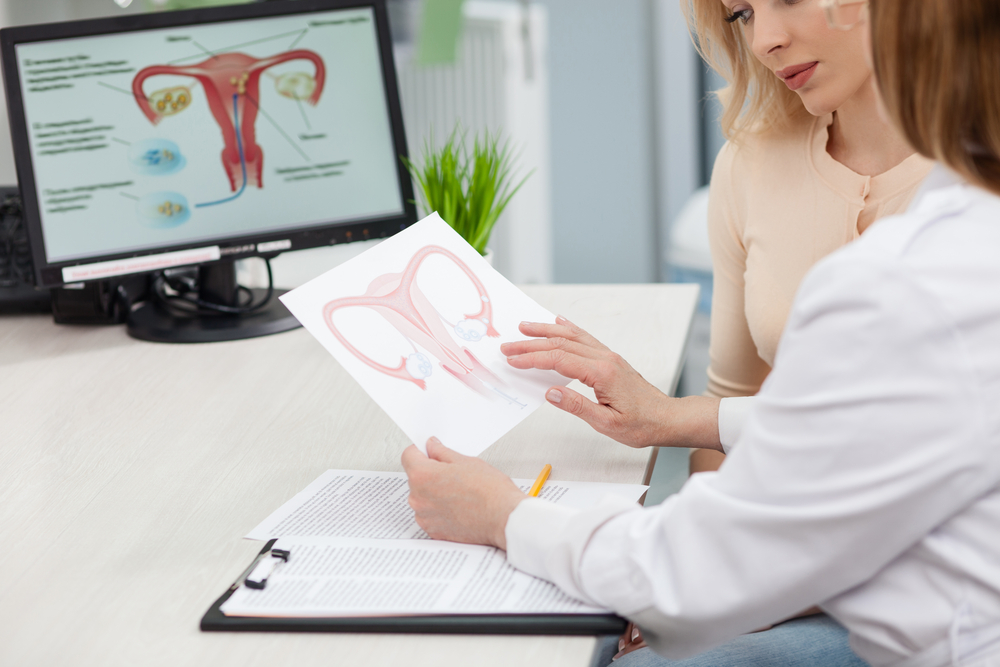Hysterectomy is the second most common significant operation performed on females inside the United States (the most common being cesarean section delivery). Every year, more than 600,000 women undergo a hysterectomy. Despite the fact that some progressive doctors claim that up to 90% of hysterectomies are unnecessary, more conservative estimates put that number between 20–30%. Either way, that is a lot of women who may be having unnecessary hysterectomies.
Women are asked to consider an elective hysterectomy for quite a few reasons. The most common are intense bleeding, when many other treatments have been tried and failed; large fibroids; endometrial polyps; endometriosis, causing debilitating pain and discomfort; and other endometrial concerns. Some women are fed up with the discomfort or the bloating that accompanies a large fibroid uterus, or have a uterine prolapse (a condition in which the uterus drops). More serious indications include cancers of the uterus or ovaries — conditions that truly merit immediate surgery. However, if we take a closer look, the latter are relatively uncommon and leave women with few choices. This topic and conversation is geared toward women who are considering surgery for less clear-cut reasons.
Heavy bleeding
Throughout traditional medical practices heavy blood loss is termed “dysfunctional uterine bleeding” when it is not the normal amount of bleeding but no demonstrable organic pathology is found. Diagnosis is made by exclusion since organic pathology always has to be ruled out.
What may be more useful for us to identify as “dysfunctional,” or imbalanced, are the environmental and lifestyle influences affecting our hormones and sending the uterus mixed messages. Every now and then these influences lead to a state of estrogen dominance. In other cases the menses may be out of sync because of general hormonal imbalance. Whichever is the case, tuning in and paying attention to what the body and mind require can restore balance naturally. Furthermore, what is dysfunctional for one woman may not be for another, and the term is somewhat subjective by nature, so it should be discussed with a knowledgeable and experienced provider.
Having reached a state of hormonal imbalance, a woman’s body can get stuck, and even her greatest efforts to restore balance can take quite a few months. The annoyance of having to change pads hourly, double up on tampons, wash extra linen, never wear white at that time of the month and time activities around heavy flow leads several women to the end of their gynecological rope. When women in this situation ask for a hysterectomy, nearly all doctors in America will respond by scheduling surgery as soon as possible – and who can blame them? But in our book, surgery should never be the first, or even the second, recourse in the face of heavy bleeding. That is because we have seen firsthand how much things can change when the right steps are taken. The good news is, no matter what, an old dictum from surgery generally applies: bleeding eventually stops when a woman goes through menopause.
Heavy bleeding often occurs, even if it has never happened before, around perimenopause, and in several cases can be successfully addressed with many natural measures before pursuing surgery. In nearly all cases, a woman can be offered a trial of non-surgical intervention such as “medical management” (using a progesterone effect on the uterus) of dysfunctional bleeding prior to referral for “surgical management.” This approach is normally safe, as long as the lining of her uterus has been appropriately evaluated with an endometrial biopsy or D&C if necessary, and as long as her red blood count remains sufficient.
At our clinic, we’ve had excellent results treating heavy bleeding with high-dose bioidentical progesterone, in the form of creams or oral tablets, along with other supportive supplements. Lifestyle and dietary changes that decrease stress and increase core nutrition are also extremely effective in this arena.
Several bleeding issues reflect irregularities of the endometrium, so the symptoms are strongly influenced by the monthly ebb and flow of estrogen as well as progesterone. Simply because of this, these difficulties normally settle extremely well into a natural rebalancing of hormones by way of diet plan and lifestyle changes. Furthermore, a natural approach should be tried before advancing to surgical intervention. Surgery is no small matter, and the removal of organs can lead to additional problems that are different, but just as troublesome or more so. And, just as heavy bleeding dissipates with menopause, so too do conditions of the endometrium.
Postmenopausal bleeding
Postmenopausal bleeding, on the other hand, is a completely different matter, and any bleeding after menopause needs to be immediately assessed by your healthcare provider. Women with postmenopausal bleeding are often referred for vaginal ultrasound so the endometrium of the uterus can be evaluated and measured. If the endometrial thickness is above a certain width, an endometrial biopsy is recommended. Certain drugs such as Tamoxifen for breast cancer can cause thickening, and women on tamoxifen who have thickened stripes should be seen by GYN specialists for this side effect.
Adenomyosis
Constant heavy bleeding that does not stem from a discretely recognizable source such as fibroids, and which doesn’t respond to medical management, is often a result of adenomyosis of the uterus. Adenomyosis is generally referred to as endometriosis interna. In this condition, which is sometimes mistaken for uterine fibroids, the glandular endometrial lining of the uterus invades the bulk of the uterine muscle wall. This is also known as endometriosis of the muscle.
Although most women who have adenomyosis never have symptoms, it can cause the uterus to grow 2–3 times its normal size and be accompanied by severe menstrual cramping. During the pelvic exam, the uterus can feel large and bulky. It occasionally is recognized by ultrasound, more definitively by MRI, and confirmed by pathology after a hysterectomy; however it is technically seen as a benign condition.
Adenomyosis frequently fails to respond to the influence of progesterone under medical management. If you have exhausted all natural measures and still suffer with persistent heavy bleeding, you might want to enquire further about this potential diagnosis. Endometrial ablation is one alternative that has been very helpful to some, and is an alternative to hysterectomy, along with the Mirena IUD; either may be considered in certain cases.
Fibroids
No less than 40% percent of hysterectomies performed are for fibroids, which technically are not part of the endometrium. Nobody understands just what exactly causes them, but fibroids are certainly a hassle. They are extremely real and women’s concerns about them must not be dismissed as merely worrying. We suspect their growth is most likely fueled by estrogen but are unsure yet regarding the details.
Fibroids are fairly common: at least one in five women over age 35 has them. So many women think, mistakenly, that if they have fibroids they will sooner or later need a hysterectomy. This just isn’t true. Often doctors recommend a hysterectomy for patients with fibroids even when they are symptom free! This is like cutting off your nose to spite your face.
I have had countless patients who deal with their fibroids successfully through dietary and lifestyle changes, including looking at their stress levels and working to change them; supplements; and acupuncture, if they are having symptoms. We suggest the book Women’s Bodies, Women’s Wisdom, written by my friend and colleague, Christiane Northrup, MD, which includes a fabulous section on treating and living with fibroids without surgical interventions. See our articles for more information on the causes as well as natural treatment for fibroids.
Fibroids may cause bleeding and pain or discomfort, an ever present sense of fullness and can grow in some, but certainly not all, cases. The size of a fibroid is often described as though someone was pregnant, comparing it to the gestational age of the fetus — for example, a 5-month size fibroid — or it can be described as a fruit (the size of a grapefruit or orange, etc). Women can have several fibroids of various sizes and shapes. Some fibroids grow very little over time, and many women are oblivious to the fact that they have them. Your healthcare provider can often feel an enlargement of the uterus while doing a pelvic exam and may order an ultrasound if they feel it is warranted.
An ultrasound will measure the fibroid and better evaluate any other abnormalities that are there as well. You could be sent for repeat ultrasounds to make certain your fibroids are not growing too big or too quickly over time. Your doctor may in addition order a CT scan or an MRI if additional information is needed. Fibroids are very seldom cancerous and do not need to be biopsied. But remember that any kind of dysfunctional uterine bleeding should probably be evaluated with an endometrial biopsy to rule out any other causes for the bleeding.
Polyps
Uterine polyps or endometrial polyps are irregularities of the inner uterine lining (something like fleshy skin tags, only on the inside). Polyps are often the source of irregular bleeding and can be a large nuisance, BUT they are not commonly cancerous. Polyps of the uterine lining are often difficult to see on regular ultrasounds, but a “sono-hyst” (sonohysterography) or saline-infused ultrasound is much better at diagnosing this more accurately. It is not unusual to obtain fragments of a polyp when getting the results back on a sampling that was taken when an endometrial biopsy was done.
Nearly all endocervical polyps can be removed through the vagina, as they are present at the opening of the cervix. Uterine/endometrial polyps are usually removed via the D&C with hysteroscopy method, which is slightly more invasive, but definitely less traumatic than a hysterectomy.
Endometriosis
Endometriosis is a condition that is normally more painful than dangerous. A lot of women who have endometriosis are unaware of its presence until they attempt to become pregnant. Endometriosis can cause severe fertility problems and always needs to be ruled out if someone has cramping with their menses and can’t get pregnant. It can also cause irregular spotting, bleeding, and pain, including pain with intercourse. For women with severe endometriosis, the pain can be unbearable, especially around their period, and/or around ovulation.
Acupuncture can be very helpful for pain management. If fertility is an issue, PT techniques such as integrative manual therapy (IMT) and Clear Passages could be investigated. Both these techniques have been quite successful in increasing fertility when all else failed. Laparoscopy is often used in more severe cases for conclusive diagnosis and treatment. For more precise information on alternative treatments for endometriosis, see our articles on this topic.
If your decision to get a hysterectomy is optional, consider yourself fortunate. You have the time to research your options and figure out what the best choice is before undergoing surgery. And with more and more options becoming available, there really is a choice.







